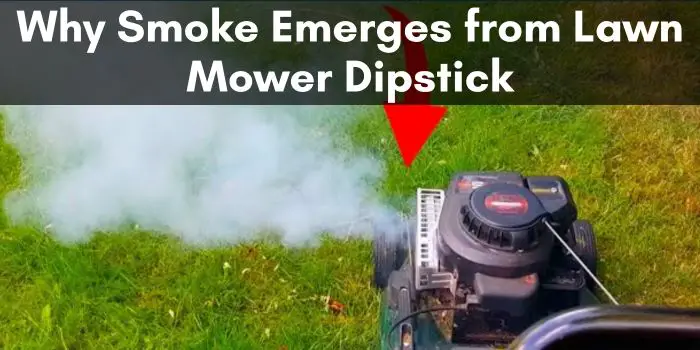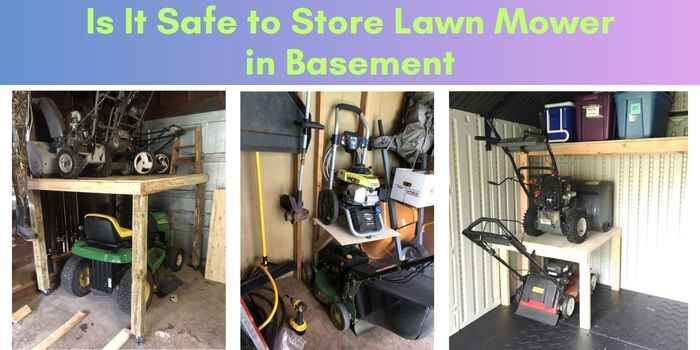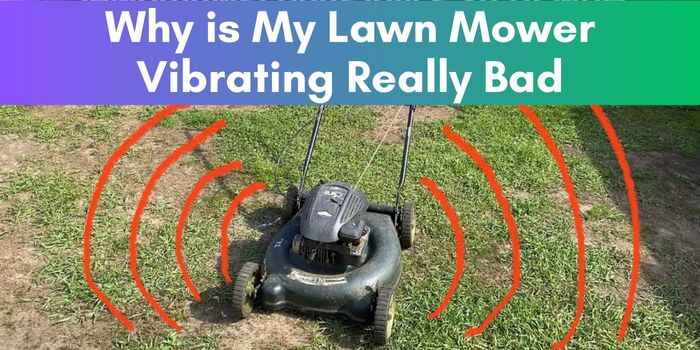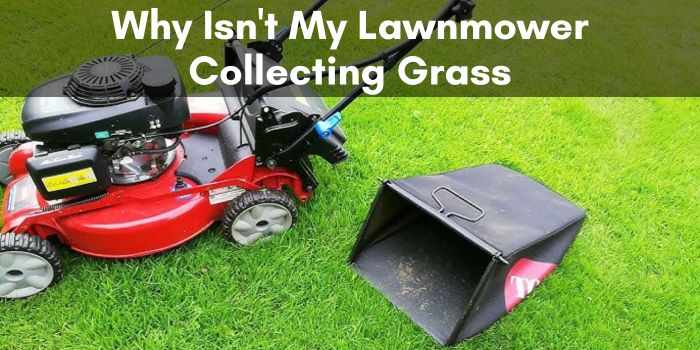Why Smoke Emerges from Lawn Mower Dipstick: Causes & Fixes
Smoke emanating from a lawn mower’s dipstick often signals overheating or oil contamination. An overfilled oil chamber or a clogged engine breather can cause this issue.
Your lawn mower is a crucial tool for maintaining a pristine yard, but noticing smoke pouring out from under the dipstick can quickly raise alarms.
Recognizing the seriousness of this problem is critical for any lawn enthusiast or homeowner.
Smoke from the dipstick tube could indicate underlying issues that need immediate attention to prevent further damage to your mower’s engine.
Quick identification and resolution of such smoking issues will keep your gardening schedule uninterrupted and your lawn in top shape.
Smoke Signals: Assessing Your Lawn Mower’s Health
When your lawn mower starts puffing out smoke, it’s more than just an alarming scene. It hints at potential internal issues worth immediate attention.
Identifying the reason behind smoke coming from a lawn mower’s dipstick can save your machine from extensive damage and keep your lawn maintenance on track.
Let’s decipher the smoke signals together.
Recognizing Unusual Mower Behavior
Familiarize yourself with your lawn mower’s normal performance. The appearance of smoke is a clear indication that something is amiss. Be on the lookout for:
- Exhaust color: Blue, white, or black smoke each tell a different story.
- Operational issues: Is your mower harder to start? Does it run unevenly?
- Oil leaks: Spots on the ground could lead to low oil levels and cause smoking.
The Significance Of Smoke From The Dipstick
Detecting smoke from the dipstick tube is a signal you cannot ignore.
| Smoke Color | Possible Causes |
|---|---|
| Blue Smoke | Burning oil due to overfill or a faulty engine component |
| White Smoke | Condensation or minor oil overflow |
| Black Smoke | Richer fuel mixture or clogged air filter |
Immediate action can prevent further damage. Check oil levels, replace filters, or consult a professional.
Internal Combustion Basics
Seeing smoke rise from your lawn mower’s dipstick can be alarming.
Understanding the basics of internal combustion is key to diagnosing the issue. Engines in lawn mowers ignite fuel to generate power.
This process creates heat and pressure, demanding a well-maintained system to operate safely.
How Lawn Mower Engines Work
Lawn mower engines employ a simple yet efficient mechanism.
They convert fuel into motion to spin the cutting blade. Here’s a quick look at the process:
- Fuel mixes with air in the carburetor.
- The mixture moves to the cylinder, where a spark ignites it.
- Expanding gases from the ignition push the piston.
- This motion turns the crankshaft, powering the blade.
Role Of Oil In Engine Performance
Oil within an engine is essential. It serves several crucial roles:
- Lubricates moving parts to reduce friction.
- Helps cool the engine by transferring heat.
- Fights corrosion and rust on engine components.
- Seals gaps between the piston and the cylinder wall.
- Cleans by suspending dirt and debris.
Optimal engine performance hinges on maintaining clean and sufficient oil. Neglect can lead to overheating, increased wear, and, as evidenced, smoke from the dipstick.
Common Culprits: Identifying Causes Of Smoke
Notice smoke coming from your lawn mower’s dipstick? It’s a sign that your mower needs attention. Let’s explore common causes for this. Your mower might have a simple fix or need a thorough check. Keep an eye on these usual suspects.
Overfilled Oil Reservoir
Too much oil in your lawn mower can cause smoking. It’s like pouring water into a full cup; the excess has to go somewhere.
- Check the oil level with the dipstick.
- Ensure you wipe the dipstick clean first.
- See if the oil reaches above the ‘Full’ mark.
Drain the excess oil if overfilled. Follow these simple steps:
- Turn off the engine and let it cool.
- Remove the oil cap and dipstick.
- Tilt the mower on its side.
- Let the extra oil drain into a pan.
Worn Out Engine Seals And Gaskets
Old seals and gaskets can cause smoke too. They keep oil in place. When they wear out, oil can leak and burn.
| Signs of Worn Seals/Gaskets | What To Do |
|---|---|
| Oil stains on the mower or garage floor. | Check seals around the engine. |
| Burning smell while running the mower. | Replace any damaged seals or gaskets. |
Oil Quality And Grades
Spotting smoke from a lawnmower dipstick can be alarming. The culprit often lies within the realm of oil quality and grades.
Just lawnmowers need the correct type of oil to function properly. Not all oils are the same. Each type serves a specific purpose. They protect the engine and keep it running smoothly.
The Impact Of Using Incorrect Oil Type
Every oil type has a unique formula. It is designed for certain temperatures and engine designs. Using the wrong oil can cause major damage.
- Increased friction – Wrong oils may be too thin or too thick. They won’t lubricate well.
- Overheating – Incorrect oil fails to absorb heat, putting engines at risk.
- Smoke and damage – Low-grade oil burns quickly. It can lead to smoke from the dipstick.
Always check the lawn mower’s manual. Find the recommended oil type. Follow it strictly.
Checking And Maintaining Oil Viscosity
Oil viscosity refers to its resistance to flow. Temperature affects it greatly.
To keep the engine happy, use oil with the right viscosity. An oil that’s too thick will not flow smoothly. If it’s too thin, it won’t provide enough protection.
Regular checks matter. Ensuring the oil is at the proper level and changed out when it loses its effectiveness is key.
| Viscosity | Temperature Range | Effectiveness |
|---|---|---|
| Low Viscosity | Colder climates | Better flow at engine start |
| High Viscosity | Warmer climates | Better engine protection |
Change oil after every 50 hours of use or at least once a season. This act keeps your mower’s engine clear of smoke issues.
When Overheating Takes Its Toll
Why is Smoke Coming from a Dipstick in My Lawn Mower? Discovering smoke emerging from your lawn mower’s dipstick can signal a significant issue: overheating.
It’s essential to understand why this happens and the consequences of neglecting it. Exploring the symptoms and risks associated with an overheating engine sheds light on the importance of timely intervention.
Symptoms Of An Overheating Lawn Mower Engine
Recognizing the signs that your lawn mower is too hot is key. Here are clear symptoms to look out for:
- Excess Smoke: Smoke billowing from the exhaust or dipstick tube.
- Loss of Power: The engine becomes sluggish and less responsive.
- Engine Knock: Unusual knocking sounds emerge from the engine.
- Hot Surfaces: The engine cover feels extremely hot to the touch.
Risks Of Continuous Operation While Overheated
Continuing to use your lawn mower when it’s overheating carries serious risks:
| Component Damage | Consequences |
|---|---|
| Engine parts | Can warp, break, or melt, leading to costly repairs or replacements. |
| Oil quality | Deteriorates, reducing lubrication and causing further friction and heat. |
| Overall performance | Declines, with possible engine failure and total unit breakdown. |
It’s crucial to stop using the mower right away. Allow the engine to cool. Then, diagnose and fix the problem to prevent further damage.
Breather Tube Blockages
Encountering smoke from your lawn mower’s dipstick can be alarming. This may indicate a breather tube blockage.
Let’s dive into what this means for your lawn mower.
Function Of The Breather Tube In Engine Health
The breather tube plays a pivotal role in your lawn mower’s engine. It regulates pressure within the crankcase. This tube vents harmful gases away from the engine. A blockage can cause pressure buildup.
This leads to oil escaping through the dipstick. It might cause smoke and other issues.
Cleaning And Maintenance Tips
Maintaining a clean breather tube is crucial for engine efficiency. Here are essential tips:
- Locate the Breather Tube: Refer to your mower’s manual. Find the tube’s location.
- Inspection: Check for clogs or damage.
- Cleaning: Use a soft brush and a cleaner. Gently scrub the blockages away.
- Clear pathways: Ensure the tube’s inside and connecting paths are clean.
- Replace if Necessary: Install a new tube if the old one is beyond repair.
- Regular Check-ups: Perform regular inspections to avoid future problems.
Following these steps helps keep your lawn mower in top shape. A clear breather tube means better engine performance and longevity.
A Step-by-step Fixing Guide
Is your lawn mower puffing smoke from its dipstick? Smoke signals aren’t a call for panic. Your lawn mower might need a simple fix.
Follow this guide to troubleshoot and resolve the smoke mystery in a few easy steps. The right tools and a careful approach will have your mower running smoothly again.
Assessing The Problem And Preparing Your Tools
Detect the issue correctly before diving into the fix. Lawn mower smoke can come from several sources. Gather the necessary tools:
- Wrench set
- Screwdrivers
- Cleaning cloths
- Replacement parts (if needed)
Ensure the mower is off and cooled down. Check for visible signs of damage or oil leaks.
Step-by-step Procedure For Resolving Smoke Issues
- Open the mower hood. Use the appropriate screwdriver or wrench.
- Locate the dipstick tube. Clean any debris around it with a cloth.
- Remove the dipstick and wipe it clean.
- Check oil level. If it’s too high, drain excess oil.
- Inspect for clogs in the crankcase vent. Unclog if needed.
- Inspect the dipstick tube for damage. Replace tube if necessary.
- Reinsert the dipstick firmly. Close the mower hood.
- Start the engine. Monitor for any remaining smoke.
If smoke persists, consult the mower’s manual or a professional mechanic. Regular maintenance prevents future issues. Keep those mowers running clean!
Preventive Measures: Keeping Smoke Away
Keeping your lawn mower smoke-free is crucial for its longevity and performance. Smoke from the dipstick signals internal issues, often preventable with proactive steps.
This section outlines key measures to ensure your mower runs efficiently without emitting unwanted smoke.
Regular Maintenance And Servicing
Routine checks and tune-ups keep lawn mowers in top shape. Address these tasks to prevent smoke:
- Clean or replace air filters to improve air flow.
- Inspect spark plugs for signs of wear or damage.
- Ensure cooling fins are debris-free for optimal engine temperature control.
- Check and tighten all nuts and bolts to prevent oil leaks.
- Have a professional service annually for a thorough overhaul.
Best Practices For Oil Management
Correct oil care is vital for engine health and smoke prevention. Here’s what to do:
| Task | Frequency |
|---|---|
| Check oil level | Before each use |
| Change oil | After 50 hours of use or annually |
| Use correct oil type | Refer to the owner’s manual |
In addition:
- Avoid overfilling oil to prevent blow-by and leaks.
- Ensure oil is clean and uncontaminated.
- Store your mower in a clean, dry place.
Expert Insights: When To Call The Professionals
Discovering smoke billowing from your lawn mower’s dipstick can be alarming. While some lawn mower issues are easily fixed at home, others require the keen eye of a professional.
Recognizing when to call in expert help is key to ensuring your mower’s longevity and your safety.
Attempting repairs on a smoking lawn mower might be tempting. Yet, certain problems are complex and dangerous. Here are reasons you should consider professional help:
- Smoke color and smell indicate different issues that may not be obvious to novices.
- In-depth knowledge of engine components is essential for fixing internal problems.
- Your warranty could be voided by unauthorized personal repairs.
- Professionals have the correct tools and safety equipment.
Selecting a knowledgeable technician is pivotal. To find a certified service specialist:
- Check out online reviews and ratings from other customers.
- Look for providers specializing in your mower’s brand.
- Ensure technicians have appropriate certifications.
- Ask about their experience with lawn mower repairs.
With the right help, your lawn mower will be back to its top condition, minus the smoke.
Frequently Asked Questions
What Causes Smoke From Dipstick?
Smoke from a dipstick can indicate engine overheating, worn piston rings, valve seals, or a clogged crankcase ventilation system. These issues can cause oil to burn and produce smoke.
Why Is There Steam Coming Out Of My Dipstick?
Steam from your dipstick often indicates a breached head gasket, allowing coolant to mix with the engine oil. Seek prompt professional inspection to avoid serious engine damage.
Why Is My Mower Smoking After Adding Oil?
Your mower may smoke after adding oil due to overfilling, oil spillage on the engine, or a tilted position causing oil to burn in the exhaust area. Check the oil level and clean any spills.
Why Would My Lawn Mower Be Smoking?
A smoking lawn mower typically indicates oil spillage on the engine, an overfilled oil chamber, or a clogged air filter. It may also suggest engine overheating or internal engine problems. Regular maintenance checks can help prevent such issues.
Conclusion
Smoke coming from your lawn mower’s dipstick is a serious indicator of an internal problem. While the causes can vary, it’s crucial not to ignore this issue. By carefully following the troubleshooting steps mentioned above, you can diagnose the root cause of the smoke and apply the appropriate fix.
Remember, if the problem seems overly complex or you feel uncomfortable with DIY repairs, always consult a qualified lawn mower technician. Prioritizing timely repairs will prevent further damage, ensure your mower’s longevity, and keep your lawn maintenance safe and efficient.







